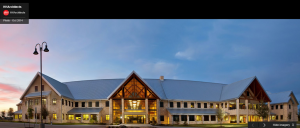 In May 2010, Gospel for Asia’s CEO and founder, K.P. Yohannan, told GFA staff that GFA might move from Carrollton, TX to Wills Point, TX. A month later, GFA acquired 350 acres which would eventually become the site of the current compound. As reported previously, GFA began building the project without sufficient funds in hand to complete it. In April 2013, GFA leaders realized they were very low on cash and approached City Bank in Lubbock for a loan. According to GFA COO, David Carroll, the City Bank was willing to loan the money but before that happened, a board under the control of Believers’ Church in India took a loan there and then sent almost $19.8 million as a gift to help GFA complete the office buildings (link).
In May 2010, Gospel for Asia’s CEO and founder, K.P. Yohannan, told GFA staff that GFA might move from Carrollton, TX to Wills Point, TX. A month later, GFA acquired 350 acres which would eventually become the site of the current compound. As reported previously, GFA began building the project without sufficient funds in hand to complete it. In April 2013, GFA leaders realized they were very low on cash and approached City Bank in Lubbock for a loan. According to GFA COO, David Carroll, the City Bank was willing to loan the money but before that happened, a board under the control of Believers’ Church in India took a loan there and then sent almost $19.8 million as a gift to help GFA complete the office buildings (link).
I have since learned that GFA borrowed $11.5 million from City Bank in Lubbock in July 2014.
In May and June of 2010, GFA staff were informed that GFA had initiated a process of acquiring land for a new headquarters and compound. During these meetings, staff were told that the move would save millions and be cheaper for staff living expenses (neither of these claims appear to be true which will be addressed in future posts). In addition, staff were told that GFA would not divert money from the field nor take loans to help construct the headquarters. However, as we have seen, GFA did both. In October 2013, nearly $19.8 million was wired to GFA from a source in Asia (later disclosed to be Believers’ Church, headed by K.P. Yohannan). In India, GFA is an arm of Believers’ Church. According to GFA’s David Carroll, Believers’ Church took a loan which allowed them to give the $19.8 million to GFA in the U.S. to complete the headquarters. In one act, it appears that GFA reneged on the earlier promises to staff. Then another loan was taken by GFA in the U.S. in 2014.
Below listen to Yohannan’s statements to staff in 2010.
One of the main complaints from former staff is a feeling of betrayal over the policies portrayed by GFA leaders and that which actually happened. The story that is emerging about the move to Wills Point is quite different than what was described at the time.
What might be more serious even than misleading statements to staff are the the misleading statements in the 2013 audit conducted by Bland Garvey. The $19.8 million payment from Believers’ Church in India to GFA was clearly a related party transaction with financial repercussion both in India and the U.S. However, the “anonymous” gift was reported in a different section of the audit:
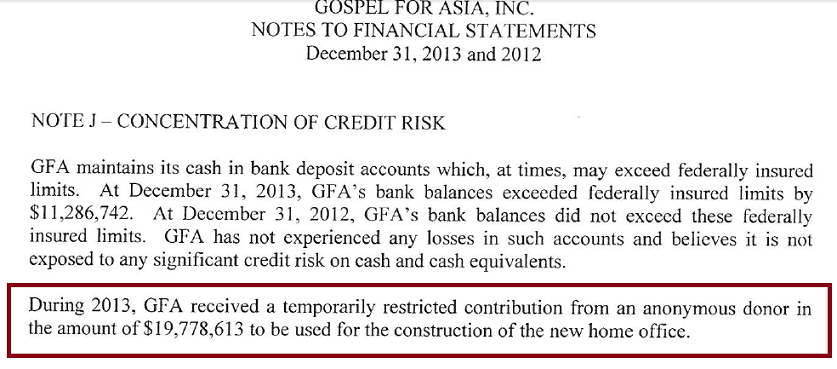
This description does not alert potential donors or potential lenders (e.g., City Bank in Lubbock, TX who loaned $11.5 million to GFA) that the cash to help build the buildings actually came from a related party (Despite his claims to the contrary, Yohannan is listed in legal documents in India as the managing trustee of Believers’ Church). Some donors might wonder why funds are so urgently needed on the field if a beneficiary of GFA’s work can turn around and give such a large gift with assurances that it can be repaid very quickly. A bank might view the credit worthiness of GFA differently if it is known that an anonymous donor is really a related party.
The ECFA review of Gospel for Asia is supposed to be completed by October when GFA is supposed to answer all outstanding questions. Looking forward to that.
Tag: K.P. Yohannan
Is Gospel for Asia's Board Independent as Defined by ECFA?
The Evangelical Council for Financial Accountability provides guidelines for governance which member organizations must follow. One important feature is independence which is defined as follows:
Board independence. The organization should take care to maintain the reality, not just the appearance of independent board governance. Requiring the predominance of independent board members helps ensure the board will take official action without partiality, undue influence, or conflict of interest.
To assess the reality of board independence, ECFA looks beyond the majority of independent board members on the board roster. ECFA is just as concerned about the reality of board independence as with the mathematical determination of a majority of independent board members.
ECFA defines independent board members as:
-
Persons who are not employees or staff members of the organization.
-
Persons who may not individually dictate the operations of the organization similar to an employee or staff member. A person who is an uncompensated CEO, for instance, is not independent.
-
Persons who are not related by blood or marriage to staff members or other board members. Blood or marriage relationships are defined for the purposes of the standard as being his or her spouse, ancestors, brothers and sisters (whether whole- or half-blood), children (whether natural or adopted), grandchildren, great-grandchildren, and spouses of brothers, sisters, children, grandchildren, and great-grandchildren.
-
Persons who do not report to, or are not subordinate to, employees or staff members of the organization.
-
Persons who do not report to, or are not subordinate to, other board members.
-
Persons who do not receive a significant amount for consulting or speaking, or any other remuneration from the organization.
-
Persons who do not have relationships with firms that have significant financial dealings with the organization, officers, directors or key employees.
-
Persons who are not the paid legal counsel, related by blood or marriage to the paid legal counsel (see definition of blood or marriage in #3 above), or are employed by the firm that is the paid legal counsel of the organization.
-
Persons who are not the auditors, related by blood or marriage to the auditors (see definition of blood or marriage in #3 above), or are employed by the auditing firm of the organization.
Gospel for Asia provided Guidestar with the names of 2015 board members as of April*:
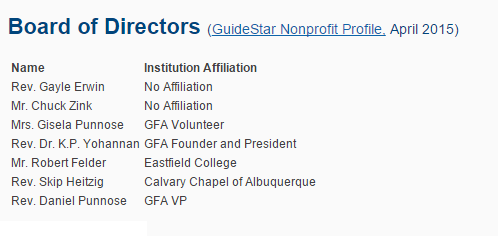
Looking at this board, it is reasonable to question the independence of a majority of members. K.P. Yohannan is President, his son is Vice President (Daniel Punnose), and his wife is a volunteer (Gisela Punnose). Chuck Zink is a major donor to GFA and his son and daughter-in-law are employees of GFA. Yohannan is also employed by GFA (#1), Daniel Punnose is employed by GFA (#1) and is a family member as is Yohannan’s wife (#3). As mentioned, Chuck Zink’s son and daughter-in-law are employed by GFA (#3). That is four out of seven.
A case could be made that Gayle Erwin’s independence has been compromised by his reliance of K.P. Yohannan and Gospel for Asia for promotion of his book, Jesus Style, and speaking engagements. According to Yohannan, GFA has translated the book into multiple languages.
In any case, it seems misleading to have “No Affiliation” by Zink’s and Erwin’s names. It is also misleading for Yohannan’s wife and son to use their Indian last name while Yohannan reverses the order for his name.
The ECFA claims that the guideline is not met by simple appearance of independence. According to Christian Today, the ECFA is reviewing GFA. I wonder if board independence is one of the items under review.
*There was a rumor that Francis Chan joined the board but as usual GFA won’t confirm this.
Update on K.P. Yohannan's Board Memberships: More Website Changes
In August, I pointed out that Gospel for Asia’s founder and CEO K.P. Yohannan claimed in May 2015 that he was not on any Gospel for Asia or Believers’ Church board in India. At the same time, court papers filed by Believers’ Church and GFA’s and BC’s own websites claimed he leads those boards. Then, I showed that after my posts, Indian Believers’ Church websites taken off line for “maintenance.”
Now, one website is back up with no mention of K.P. Yohannan as chair of the Believers’ Church trust or a member of the Believers’ Church Residential School management committee. Yohannan’s son Daniel has also been removed from the committee listing.
Yohannan may indeed have stepped off of the school’s management committee. However, there is no evidence that is has stepped down from the Believers’ Church board. He is the Metropolitan Bishop so even if the church removes his name from this web list, Yohannan remains the leader of the church.
More importantly, Yohannan was listed on numerous legal documents in India as managing trustee of Gospel for Asia and the Believers’ Church at the time the church took out a loan in India (early 2013) in order to give nearly $20 million to GFA in the U.S. for the purpose of building a massive headquarters and compound in Wills Point, TX.
Question for Gospel for Asia: How Many Indian Churches Would $45 Million Build?
In Revolution in World Missions, K,P. Yohannan says the money needed by the rest of the world’s churches is held by North American Christians. Because he believes this, he has strong words for church leaders who construct expensive churches:
Is it God’s fault that men like Brother Paulose are going hungry? I do not think so. God has provided more than enough money to meet Paulose’s needs and all the needs of the TwoThirds World. The needed money is in the highly developed nations of the West. North American Christians alone, without much sacrifice, can meet all the needs of the churches in the Two-Thirds World.
A friend in Dallas recently pointed out a new church building that cost $74 million. While this thought was still exploding in my mind, he pointed out another $7 million church building going up less than a minute away.
These extravagant buildings are insanity from a Two-Thirds World perspective. The $74 million spent on one new building in the United States could build thousands of average-sized churches in South Asia. The same $74 million would be enough to guarantee that the Good News of Jesus Christ could be proclaimed to a whole Indian state—or even some of the smaller countries of Asia.
But I rarely spoke out on these subjects. I realized I was a guest. The Americans who had built these buildings had also built the school I was now attending, and they were paying my tuition to attend. It amazed me, though, that these buildings had been constructed to worship Jesus, who said, “The foxes have holes, and the birds of the air have nests; but the Son of man hath not where to lay his head” (Matthew 8:20).
In Asia today, Christ is still wandering homeless. He is looking for a place to lay His head, but in temples “not made with human hands.” Until they can build a facility of their own, our newborn Christians usually meet in their homes. In nonChristian communities, it is often impossible to rent church facilities.
There is such an emphasis on church buildings in the United States that we sometimes forget that the Church is the people— not the place where the people meet.
But God has not called me to fight against church building programs—we try to provide adequate church buildings for the small but growing Asian churches whenever possible. What troubles me much more than the waste is that these efforts often represent a worldly mindset. Why can’t we at least earmark 10 percent of our Christian giving for the cause of world evangelism? If Christians in the United States alone had made this commitment in 2000, there would have been nearly $10 billion available for Gospel outreach! (Revolution in World Missions, pp 47-48.)
I am not drawn toward large churches or extravagance so I can relate to Yohannan’s negative reaction. Some of my interest in the Global Fund story at Mars Hill Church was driven by my curiosity about what Mars Hill did with the funds given for missions. As it turns out, much of the money (“the preponderance”) was spent on U.S. expansion rather than supporting the basic needs of mission pastors.
In my interviews with former GFA staff, a recurring topic is the discrepancy between the rhetoric of moderation and the reality of excess. A case in point is the relocation and building of the new GFA compound at Wills Point, TX. The project cost around $45 million. Staff were told that the project would save money. Former staff I have talked to indicate that they had to spend more money to live when they moved to Wills Point than before the move. More about that in the days to come.
Below is a picture of Gospel for Asia’s headquarters completed recently. There is a gallery of the GFA campus posted (for now) at HH Architects website.

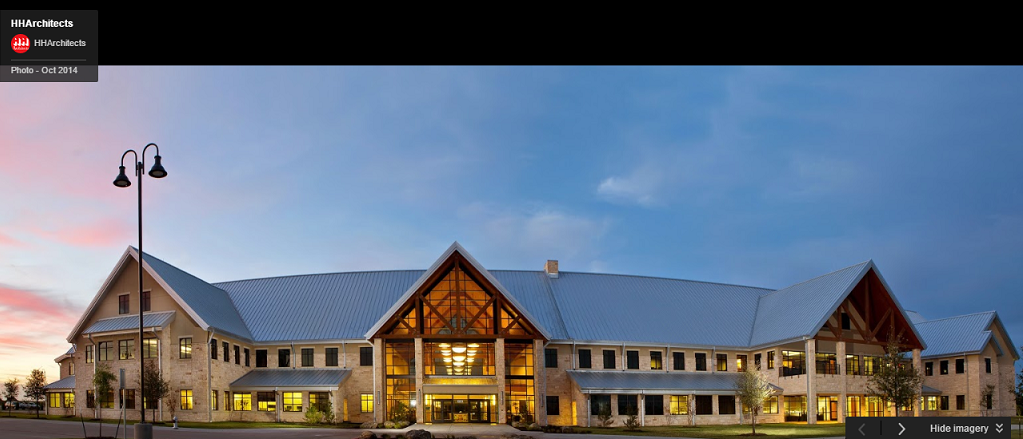

Here is the multimillion dollar chapel.
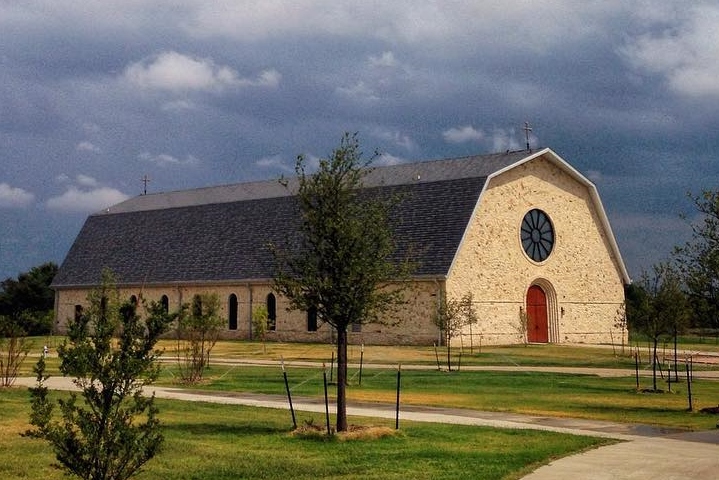
I realize things cost money and GFA needs a headquarters. However, this project required nearly $20 million from “the field” to complete. Believers’ Church in India had to borrow $20 million for GFA’s American offices.* I am trying to reconcile this what I read in Revolution in World Missions.
*I need to add that the project included staff housing, including for K.P. Yohannan. Numerous homes were built along with the HQ.
Evangelical Council for Financial Accountability Reviewing Gospel for Asia
This morning Christian Today’s Mark Woods reports that the Evangelical Council for Financial Accountability is reviewing Gospel for Asia.
Woods takes note of the controversy surrounding GFA and says that the review is expected to last until October. At that time, GFA will provide answers to “outstanding questions.”
Woods and Christian Today have provided some good coverage of this matter while everybody else appears to be sitting on their hands. Perhaps they are waiting for the review results as well.
Waiting for the completion of a review to answer basic questions is puzzling and troubling. One basic question relates to the claim that $58.5 million dollars was sent to Gospel for Asia in India during the calendar year 2013. However, during that same span of time, GFA in India only reported receiving around $6 million from GFA in the U.S. I cannot understand why GFA must wait until ECFA completes a review to address that discrepancy.
Furthermore, the 2013 audit says does not tell donors about the funds sent to Believers’ Church and two other Indian NGOs. Why not? And then there is the 2013 Canadian funds ($15 million CAD) which are not listed as being received in India despite the fact that GFA in Canada told the Canadian government those donations were being sent to India. Why does GFA need to wait until October to answer donor questions such as those asked by long-time supporter Pastor Bruce Morrison?
GFA president says he doesn’t sit on the Indian boards of GFA and Believers’ Church. Legal documents filed by GFA and BC in India say he does. Why do we need to wait until October for K.P. Yohannan to explain that discrepancy? Will Indian documents change by October?
Back room discussions continue…